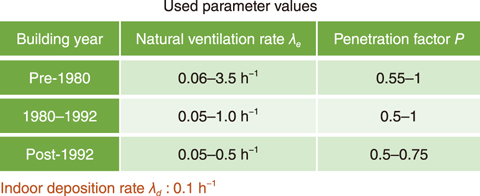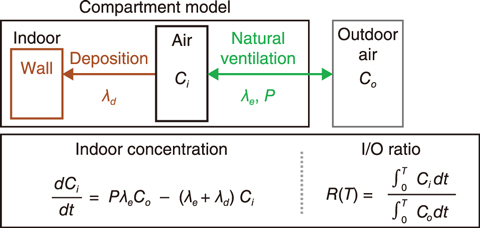
Fig.2-11 Experimental results on indoor deposition rate and penetration factor

Fig.2-12 Range of relevant parameters

Fig.2-13 Compartment model simulating the indoor/outdoor air exchange and indoor behavior
Sheltering, which is a countermeasure aimed to protect the public from exposure at a nuclear accident, is implemented until an evacuation is taken and is preferable in certain places where evacuation and re-location are not the best option for protection.
The sheltering effectiveness against internal exposure can be expressed by a ratio of the indoor-to-outdoor radioactivity concentrations (I/O ratio). The indoor concentration is controlled by the indoor/outdoor air exchange and the indoor behavior. These phenomena are expressed by the natural ventilation rate, indoor deposition rate, and penetration factor, which is the ratio of an outdoor object that penetrates indoors. These relevant parameters have been investigated in western countries to evaluate the sheltering effectiveness. However, they cannot be applied to Japanese houses, as they depend on dwelling characteristics, such as the airtightness of houses, and environmental factors, such as wind speed. Therefore, the sheltering effectiveness of Japanese houses must also be investigated.
The relevant parameters were thus investigated via literature surveys and real house experiments. Additionally, the influence of environmental factors on the I/O ratio was investigated. The natural ventilation rate was determined using indoor and outdoor CO2 measurements, and the penetration factor and indoor deposition rate were determined with indoor and outdoor aerosol measurements (Fig.2-11). The natural ventilation rate differed by the building year (Fig.2-12); houses built before 1980 had a greater ventilation rate than that of Western countries (0.125-1 h-1). The indoor deposition rate for particles of 0.3-1 μm was approximately 0.1 h-1 (Fig.2-11(a)), and the penetration factor ranged from 0.5 to 1 depending on the natural ventilation rate (Fig.2-11(b)).
The I/O ratio was then calculated by inputting the parameters shown in Fig.2-12 into the compartment model simulating the indoor/outdoor air exchange and indoor behavior (Fig.2-13). The I/O ratio was larger for older houses or higher wind speed, as the natural ventilation rate and penetration factor was greater in these cases. The I/O ratio was calculated under the assumption that all radionuclides were particulate forms and the concentration in a plume was uniform. However, in real nuclear accidents, radioiodine consists of non-reactive gaseous forms, reactive gaseous forms (I2), and particulate forms. Additionally, the concentration in a plume cannot be uniform. Unfortunately, there is little information on the relevant parameters of I2. Future work should thus investigate the failures of this assumption and relevant parameters of I2, and then use this to evaluate the sheltering effectiveness under more realistic conditions.
This study was partly supported by the Secretariat of the Nuclear Regulation Authority (NRA), Japan.